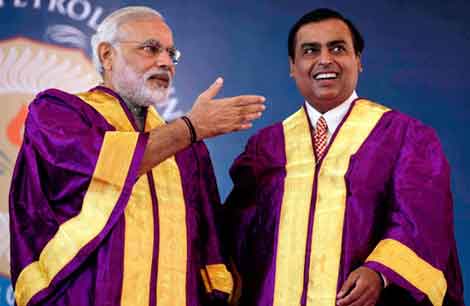
The Press Information Bureau (PIB) released a press note from the Ministry of Human Resource Development pertaining to the shortlisted Institutions of Eminence (IoE) yesterday. Much to the surprise of university professors as well as the public in general, the list included a non-existent university, Jio Institute. Accusations came shortly after the announcement speculating whether this was an instance of the crony capitalists cosying up to the powers that be, since the Jio Institute is a part of the Reliance Foundation – the 'philanthropic' wing of the Ambani empire. What is interesting in this choice, however, is the guidelines that shaped the deliberations of the committee tasked with shortlisting the IoEs.
This entire exercise has been undertaken with a view towards improving the performance of Indian universities in the global ranking systems. The fifth objective listed under clause 3 states the objective of the IoEs quite lucidly as, “to aim to be rated internationally for its teaching and research as a top hundred Institution in the world over time”.
The University Grants Commission (World Class Institutions Deemed to be Universities) Regulations, 2016 have laid down the specifications for determining how an institution – whether public or private – could be designated a World Class Institution Deemed to be University. The Regulations have further elaborated on the obligations and duties of both the institutions as well as the government. However, in August 2017, the University Grants Commission (UGC) created the UGC (Institutions of Eminence Deemed to be Universities) Regulations, 20l7, which for the most part appear to be a word by word reproduction of the earlier Regulations except for a change of nomenclature.
Some of the notable changes are:
- The corpus of funds required to be eligible in the case of a 'greenfield' proposal were reduced from Rs. 200 thousand crore to Rs. 60 crore.
- The 2016 Regulations stated that at least one faculty member must publish each year, this requirement has been changed to an average across departments.
- The 2016 Regulations stated that a plan for financial assistance to domestic students through scholarships should be present. The 2017 Guidelines include loans as a part of the financial assistance.
The IoE tag, however, comes with several perks or in the official parlance 'additional incentives'. The first falls within the purview of admission and fees structure. The admission process should be entirely based on merit and the IoE is free to devise the mode and manner of 'testing' merit. As far as foreign students are concerned, the maximum limit is thirty percent of the domestic student population. The IoE is also free to fix fees of its own accord and the fees charged will be unregulated. The guidelines specifically ban capitation fees as well as hidden charges post admission. In the event that there is a dispute between the students and the administration, an ombudsman is to be appointed by the institution.
With regard to the courses offered as well as the course structure, syllabus and credits, the IoE will have the complete autonomy and the permission of the UGC is not required. The IoE will also have absolute freedom in hiring faculty, promotions and emoluments. This is extended to even hiring “personnel from industry, etc. as faculty, who, while being experts in their areas, may not have the requisite higher academic qualifications.” It is interesting to note that the guidelines mentioned 'personnel from industry' specifically rather than stating 'persons with practical experience in various fields'.
As far as academic collaborations are concerned, the IoEs will have absolute autonomy to collaborate with domestic institutions. With foreign institutes, it is subject to two conditions, the institutes must feature in the top 500 ranking, and should not be on the 'negative list of countries' determined by the Ministry of External Affairs and the Ministry of Home Affairs. The IoEs will further have absolute financial autonomy regarding how the funds are spent. As well as being exempt from UGC inspections.
Among these characteristics of the IoEs, two points stand out. The clause dealing with student loans is vague to the extent that it is not clear whether the institute will be giving loans, or that the institute will enable the students to avail loans from banks. The other point is that the ombudsman, who would presumably mediate student grievances against the administration, is appointed by the same administration. In the event that the ombudsman does not act in an impartial manner, what recourse do students have? This becomes more pronounced since the UGC is almost entirely out of the picture when it comes to the IoEs. While on the one hand, professors all over the world are struggling against the corporatisation of education, the Government of India seems to be aiding the process.




